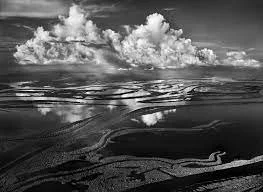Black and White Photography: An Exploration of Styles from Ansel Adams to Henri Cartier-Bresson
Black and white photography has an undeniable charm and timelessness that continues to captivate audiences around the world. It strips away the distractions of colour and emphasises the essence of the subject, creating stunning visuals that are both dramatic and emotive. In this blog post, I embark on a journey through the works of three iconic black and white photographers: Ansel Adams, Henri Cartier-Bresson and Dorothea Lange's . I’ll also explore the contributions of other notable photographers in this genre to understand the diverse styles that have shaped black and white photography.
Please note that all images in this post are owned by the photographers. Links to more of their work is posted below.
1. Ansel Adams: Capturing the Majesty of Landscapes
Ansel Adams, often referred to as the master of black and white landscape photography, was renowned for his ability to capture the grandeur of nature in stunning detail. His landscapes are characterised by immaculate technical precision, impeccable composition, and a deep sense of reverence for the natural world.
Adams' iconic series, "Mural Project," showcased landscapes from Yosemite National Park, where he captured awe-inspiring scenes of snow-capped mountains, cascading waterfalls, and serene lakes. Through his Zone System technique, he achieved a broad tonal range, allowing him to bring out the finest details in both highlights and shadows, adding depth and dimension to his images.
The ethereal quality of Adams' work was further enhanced by his mastery of long exposure techniques, particularly when photographing waterfalls and cloud formations. His dedication to the craft of black and white photography made him a legend, inspiring generations of photographers to come.
Website: https://www.anseladams.com/
2. Henri Cartier-Bresson: The Decisive Moment in Gritty Realism
Henri Cartier-Bresson, a pioneer of modern photojournalism, took a different approach to black and white photography. His style was rooted in capturing candid, unposed moments that revealed the true essence of human life. Cartier-Bresson's concept of the "decisive moment" emphasised capturing fleeting instants when all elements of a scene came together harmoniously.
His photographs of urban scenes immortalised the raw reality of life in bustling cities. Whether it was a street corner in Paris or a bustling market in India, Cartier-Bresson had an extraordinary ability to freeze time and reveal the poetry hidden within ordinary moments.
Cartier-Bresson's use of geometry and leading lines lent a sense of order and structure to his photographs, even in the midst of chaos. He believed in simplicity and refrained from excessive post-processing, allowing his images to convey an authentic and unfiltered perspective of the world.
Website: https://www.magnumphotos.com/photographer/henri-cartier-bresson/
All images are copyright of: Henri Cartier-Bresson
3. Dorothea Lange: Social Documentary and Empathy Through the Lens
Moving beyond the landscapes and urban scenes, Dorothea Lange's work focused on social documentary photography during some of America's most challenging times. Her powerful black and white images from the Great Depression, particularly her iconic photograph "Migrant Mother," spoke volumes about the hardships faced by families during that era.
Lange's ability to empathise with her subjects and capture their emotions with sensitivity and dignity made her one of the most influential photographers of her time. She used her lens to raise awareness about social issues and advocated for positive change through her evocative imagery.
All images are copyright of: Dorothea Lange
4. Sebastião Salgado: The Human Condition in Black and White
Sebastião Salgado (a photographer I greatly admire), a contemporary black and white photographer, carries on the tradition of social documentary photography. His projects have taken him to some of the most remote and deprived corners of the world, capturing te struggles and resilience of humanity.
Salgado's work is characterised by its breathtaking scale and the stark contrast between light and shadow. His projects like "Genesis" and "Workers" showcase the immense diversity of the human experience, from pristine landscapes to the gritty reality of labourers toiling in harsh conditions.
His dedication to capturing the human condition with unyielding honesty and a deep sense of compassion has earned him international acclaim and further solidified black and white photography's relevance in the modern world.
Social Media page: https://www.instagram.com/sebastiaosalgadooficial
Conclusion
Black and white photography has evolved over the years, revealing a myriad of styles and approaches that showcase the power of monochromatic imagery. From Ansel Adams' majestic landscapes to Henri Cartier-Bresson's gritty urban scenes and the social documentary work of photographers like Dorothea Lange and Sebastião Salgado, black and white photography continues to be a timeless and impactful medium.
Each photographer mentioned in this blog post brought their unique vision and perspective to the genre, inspiring future generations to explore and experiment with the art form. As we reflect on their contributions, let us celebrate the enduring allure of black and white photography and its ability to evoke emotions, tell stories, and capture the essence of the world around us.












